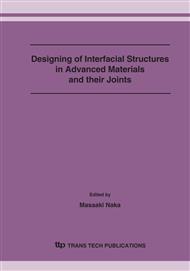[1]
H.P. Degischer and B. Kriszt: Handbook of Cellular Metals: Production, Processing, Applications, (Wiley-VCH Verlag GmbH, Weinheim, 2002).
DOI: 10.1002/3527600558
Google Scholar
[2]
V.I. Shapovalov: Porous and Cellular Materials for Structural Applications, ed. by D.S. Schwartz, D.S. Shih, A.G. Evans and H.N.G. Wadley, (MRS, Warrendale, USA, 1998), pp.281-290.
Google Scholar
[3]
H. Nakajima: Mater. Integration 12 (1999), pp.37-44.
Google Scholar
[4]
H. Nakajima: The Production & Tech. 51 (1999), pp.60-62.
Google Scholar
[5]
H. Nakajima: Boundary 15 (1999), pp.9-11.
Google Scholar
[6]
H. Nakajima: J. High Temp. Mater. 26 (2000), pp.95-100.
Google Scholar
[7]
H. Nakajima: Bull. The Iron and Steel Institute of Japan 6 (2001), pp.701-707.
Google Scholar
[8]
H. Nakajima, S. K. Hyun, K. Ohashi, K. Ota and K. Murakami: Colloids Surf. A 179 (2001), pp.209-214.
Google Scholar
[9]
S.K. Hyun, K. Murakami and H. Nakajima: Mater. Sci. Eng. A 299 (2001), pp.241-248.
Google Scholar
[10]
S.K. Hyun and H. Nakajima: Mater. Sci. Eng. A 340 (2003), pp.258-264.
Google Scholar
[11]
K. Ota, K. Ohashi and H. Nakajima: Mater. Sci. Eng. A 341 (2003), pp.139-143.
Google Scholar
[12]
T. Ogushi, H. Chiba, H. Nakajima and T. Ikeda: J. Appl. Phys., 95 (2004), pp.5843-5847.
Google Scholar
[13]
T. Ikeda and H. Nakajima: J. Jpn. Foundry Eng. Soc. 74 (2002), pp.812-816.
Google Scholar
[14]
T. Ikeda, H. Hoshiyama and H. Nakajima: J. Jpn. Inst. Light Met. 54 (2004), pp.388-393.
Google Scholar
[15]
S.K. Hyun and H. Nakajima: Mater. Trans. 43 (2002), pp.526-531.
Google Scholar
[16]
S.K. Hyun, T. Ikeda and H. Nakajima: Sci. and Technol. Adv. Mater. 5 (2004), pp.201-205.
Google Scholar
[17]
M. Tane, T. Ichitsubo, H. Nakajima, S.K. Hyun and M. Hirano: Acta Mater. 52 (2004), pp.5195-5201.
Google Scholar
[18]
U. Dilthey and M. Kessel: Schweißen und Schneiden, DVS-Berichte 220 (2002), pp.216-218.
Google Scholar
[19]
Th. Bölinghaus and W. Bleck: Cellular Metals and Metal Foaming Technology, (MIT-Verlag, 2001), pp.495-500.
Google Scholar
[20]
A. G. Pogibenko, V. Y. Konkevich, L. A. Arbuzova and V. I. Ryazantsev: Weld. Int. 15 (2001), pp.312-316.
Google Scholar
[21]
T. Bernard, J. Burzer and H. W. Bergmann: J. Mater. Process. Tech. 115 (2001), pp.20-24.
Google Scholar
[22]
K. Kitazono, A. Kitajima, E. Sato, J. Matsushita and K. Kuribayashi: Mater. Sci. Eng. A 327 (2002), pp.128-132.
Google Scholar
[23]
H. Haferkamp, J. Bunte, D. Herzog and A. Ostendorf: Sci. Technol. Weld. Joining 9 (2004), pp.65-71.
Google Scholar
[24]
T. Murakami, K. Nakata, T. Ikeda, H. Nakajima and M. Ushio: Mater. Sci. Eng. A 357 (2003), pp.134-140.
Google Scholar
[25]
T. Murakami, T. Tsumura, T. Ikeda, H. Nakajima and K. Nakata: submitted to Mater. Sci. and Eng. A.
Google Scholar
[26]
T. Tsumura, T. Murakami, S.K. Hyun, H. Nakajima and K. Nakata: Mater. Sci. Forum Vol. 502 (2005), pp.499-504.
Google Scholar
[27]
J. Mazumder and W.M. Steen: J. Appl. Phys., 51 (1980) 941-947.
Google Scholar
[28]
J. Goldak, A. Chakravarti and M. Bibby: Metall. Trans. B 15 (1984) 299-305.
Google Scholar
[29]
I. Miyamoto, H. Maruo and Y. Arata: Laser Processing: Fundamentals, Applications, and Systems Engineering, SPIE Vol. 668 (1986) 11-18.
Google Scholar
[30]
T. Zacharia, S.A. David, J.M. Vitek and T. Devroy: Metall. Trans. A 20 (1989) 957-967.
Google Scholar
[31]
P. Michaleris and A. DeBiccari: Weld. J. 76 (1997) 172s-181s.
Google Scholar
[32]
G. Yu, K. Masubuchi, T. Maekawa and N.M. Patrikalakis: Transactions of the ASME, J. Manuf. Sci. Eng. 123 (2001) 405-410.
Google Scholar
[33]
W.S. Chang and S.J. Na: J. Mater. Process. Tech. 120 (2002) 208-214.
Google Scholar
[34]
S.A. Tsirkas, P. Papanikos and Th. Kermanidis: J. Mater. Process. Tech. 134 (2003) 59-69.
Google Scholar
[35]
Dictionary of Physics Editors Committee, Dictionary of Physics, reduced-size ed., (Baifukan Co. Ltd., Tokyo, 1984), p.1537.
Google Scholar
[36]
E. A. Brandes: Smithells Metal Reference Book, 6th ed., (Butterworths, London, 1983), 17-7.
Google Scholar
[37]
Y. Arata: Transactions of JWRI 2 (1973), pp.119-120.
Google Scholar


